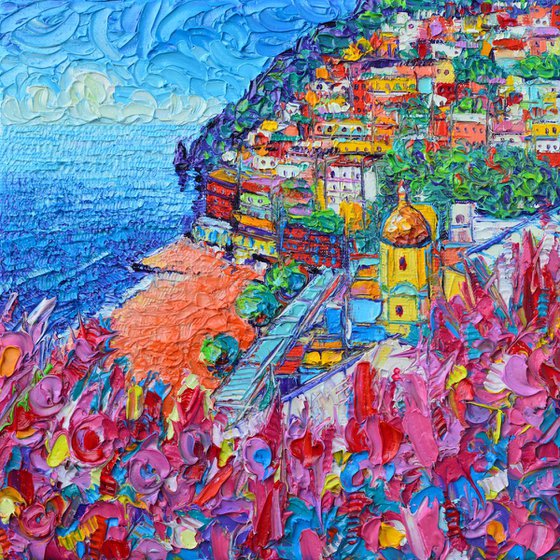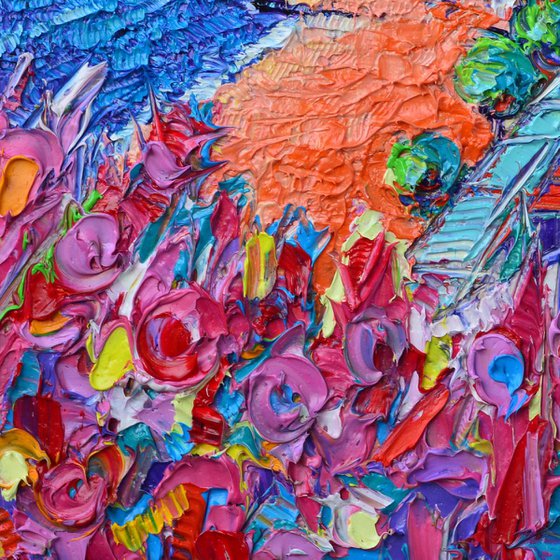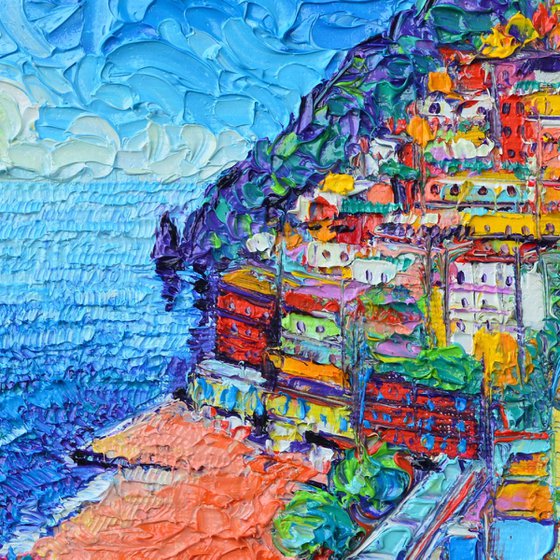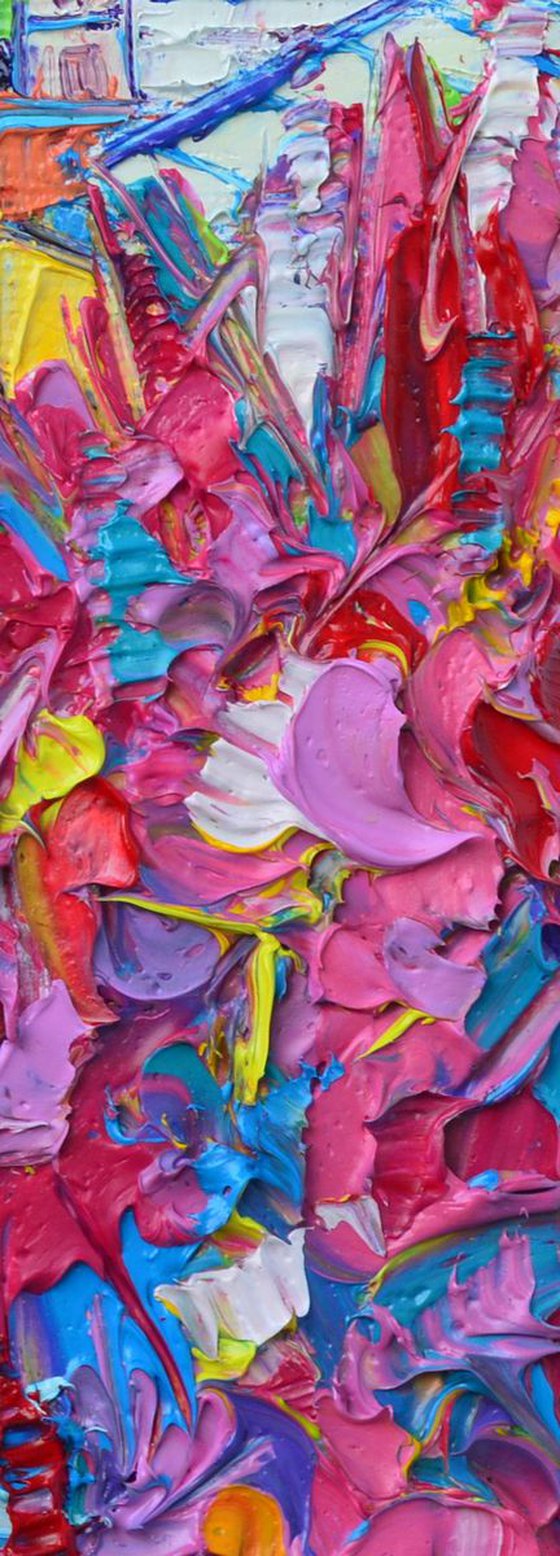Main Navigation
Original artwork description:
Highly textured impasto palette knife modern impressionist oil painting on stretched canvas ( square format ) 20 x 20 cm , depth - 2 cm .
I painted this work during last summer after I revisited some of my most favorite places in Italy. I was back to Amalfi Coast also.
I realized this modern textural impressionist oil painting in impasto technique by applying thick layers of oil paints with different types of palette knives. In this way I am able to create various palette knife strokes and textures that, by interacting one with each other, give a semi abstract feeling to my paintings.
Positano seen from above with the church of Santa Maria Assunta and the Marina Grande beach...
POSITANO COLORS AMALFI COAST ITALY is a semi abstract stylized cityscape , modern impasto textural impressionist palette knife oil painting on stretched canvas by Ana Maria Edulescu.
Positano is a village and comune on the Amalfi Coast (Costiera Amalfitana), in Campania, Italy, mainly in an enclave in the hills leading down to the coast. Positano was an essential stop for the ancient Greeks and Phoenicians on their expeditions to western areas. It is said that the coastal village was named after Poseidon, God of the Sea. Positano became a wealthy market port from the 15th to 17th century and has only continued to grow in popularity over time. Back then they traded food such as fish and other resources. Positano was a port of the Amalfi Republic in medieval times, and prospered during the sixteenth and seventeenth centuries. By the mid-nineteenth century, however, the town had fallen on hard times. More than half the population emigrated, mostly to America. Positano was a relatively poor fishing village during the first half of the twentieth century. It began to attract large numbers of tourists in the 1950s, especially after John Steinbeck published his essay about Positano in Harper's Bazaar in May, 1953: "Positano bites deep", Steinbeck wrote. "It is a dream place that isn’t quite real when you are there and becomes beckoningly real after you have gone."
The church of Santa Maria Assunta features a dome made of majolica tiles as well as a thirteenth-century Byzantine icon of a black Madonna. According to local legend, the icon had been stolen from Byzantium and was being transported by pirates across the Mediterranean. A storm had blown up in the waters opposite Positano and the frightened sailors heard a voice on board saying "Posa, posa!" ("Put down! Put down!"). The icon was unloaded and carried to the fishing village and the storm abated.
The Marina Grande beach is at the base of the cliff side town of Positano and is the most recognized beach in the town. Other popular beaches include Fornillo beach and Arienzo beach.
Materials used:
oil paints, canvas, palette knives
Tags:
#italy colors #ana edulescu #edulescu palette knife oil painting #italy beach #edulescu art #stylized cityscape #stylized city #stylized cities #positano aerial view #edulesca #abstract #landscape #seascape #abstract art #abstract painting #colorful #red #modern #green #impressionism #sea #texture #colourful #abstraction #impressionist #cityscape #abstracts #beach scene #city #architecture #seaside #impressionistic #boats #palette knife #impasto #sea and sky #city scene #italy #textures #landscapes #boat #rocks #architectural #harbour #abstract cityscape #sea life #italian art #cityscapes #italian landscape #seashore #harbor #panorama #european artist #fishing boat #italian #italian village life #panoramic landscapes #marina #fishing boats #aerial #panoramic #italy landscape #rocks sea and sky #italy cityscape #italy painting #stylized #modern impressionism #european landscape #fishing harbour #picturesque #abstract city #liguria #italian seascape #rocks and sea #amalfi coast #red boat #colorful houses #colourful houses #rocks in the sea #aerial landscape #textured oil painting #italian village #capri italy #naples #rocks abstract modern #edulescu #positano italy painting #aerial perspective #positano painting #positano #amalfi #abstract cities #amalfi italy #positano italy #positano beach #procida #procida island #positano art #procida bay #modern impasto painting #ana maria edulescu #italian island #five lands #naples bay #marina corricella #amalfi art #stylized painting #colorful fishing boats #impressionist palette knife oil paintingPOSITANO COLORS AMALFI COAST ITALY modern impressionism impasto textural palette knife oil painting by Ana Maria Edulescu abstract cities Oil painting
by ANA MARIA EDULESCU
56 Artist Reviews
£219.1 Sold
- Oil painting on Canvas
- One of a kind artwork
- Size: 20 x 20 x 2cm (unframed) / 20 x 20cm (actual image size)
- Ready to hang
- Signed on the back
- Style: Impressionistic
- Subject: Architecture and cityscapes
Do you like this artwork?
This artwork has sold, but the artist is accepting commission requests. Commissioning an artwork is easy and you get a perfectly personalised piece.
Loading
Original artwork description
Highly textured impasto palette knife modern impressionist oil painting on stretched canvas ( square format ) 20 x 20 cm , depth - 2 cm .
I painted this work during last summer after I revisited some of my most favorite places in Italy. I was back to Amalfi Coast also.
I realized this modern textural impressionist oil painting in impasto technique by applying thick layers of oil paints with different types of palette knives. In this way I am able to create various palette knife strokes and textures that, by interacting one with each other, give a semi abstract feeling to my paintings.
Positano seen from above with the church of Santa Maria Assunta and the Marina Grande beach...
POSITANO COLORS AMALFI COAST ITALY is a semi abstract stylized cityscape , modern impasto textural impressionist palette knife oil painting on stretched canvas by Ana Maria Edulescu.
Positano is a village and comune on the Amalfi Coast (Costiera Amalfitana), in Campania, Italy, mainly in an enclave in the hills leading down to the coast. Positano was an essential stop for the ancient Greeks and Phoenicians on their expeditions to western areas. It is said that the coastal village was named after Poseidon, God of the Sea. Positano became a wealthy market port from the 15th to 17th century and has only continued to grow in popularity over time. Back then they traded food such as fish and other resources. Positano was a port of the Amalfi Republic in medieval times, and prospered during the sixteenth and seventeenth centuries. By the mid-nineteenth century, however, the town had fallen on hard times. More than half the population emigrated, mostly to America. Positano was a relatively poor fishing village during the first half of the twentieth century. It began to attract large numbers of tourists in the 1950s, especially after John Steinbeck published his essay about Positano in Harper's Bazaar in May, 1953: "Positano bites deep", Steinbeck wrote. "It is a dream place that isn’t quite real when you are there and becomes beckoningly real after you have gone."
The church of Santa Maria Assunta features a dome made of majolica tiles as well as a thirteenth-century Byzantine icon of a black Madonna. According to local legend, the icon had been stolen from Byzantium and was being transported by pirates across the Mediterranean. A storm had blown up in the waters opposite Positano and the frightened sailors heard a voice on board saying "Posa, posa!" ("Put down! Put down!"). The icon was unloaded and carried to the fishing village and the storm abated.
The Marina Grande beach is at the base of the cliff side town of Positano and is the most recognized beach in the town. Other popular beaches include Fornillo beach and Arienzo beach.
Materials used:
oil paints, canvas, palette knives
Tags:
#italy colors #ana edulescu #edulescu palette knife oil painting #italy beach #edulescu art #stylized cityscape #stylized city #stylized cities #positano aerial view #edulesca #abstract #landscape #seascape #abstract art #abstract painting #colorful #red #modern #green #impressionism #sea #texture #colourful #abstraction #impressionist #cityscape #abstracts #beach scene #city #architecture #seaside #impressionistic #boats #palette knife #impasto #sea and sky #city scene #italy #textures #landscapes #boat #rocks #architectural #harbour #abstract cityscape #sea life #italian art #cityscapes #italian landscape #seashore #harbor #panorama #european artist #fishing boat #italian #italian village life #panoramic landscapes #marina #fishing boats #aerial #panoramic #italy landscape #rocks sea and sky #italy cityscape #italy painting #stylized #modern impressionism #european landscape #fishing harbour #picturesque #abstract city #liguria #italian seascape #rocks and sea #amalfi coast #red boat #colorful houses #colourful houses #rocks in the sea #aerial landscape #textured oil painting #italian village #capri italy #naples #rocks abstract modern #edulescu #positano italy painting #aerial perspective #positano painting #positano #amalfi #abstract cities #amalfi italy #positano italy #positano beach #procida #procida island #positano art #procida bay #modern impasto painting #ana maria edulescu #italian island #five lands #naples bay #marina corricella #amalfi art #stylized painting #colorful fishing boats #impressionist palette knife oil painting14 day money back guaranteeLearn more







